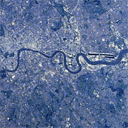
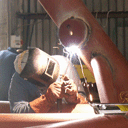
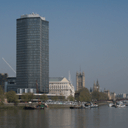
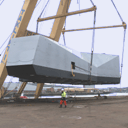
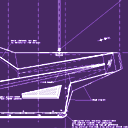
Design
Click on photos for enlargements.
Page 3 - Architecture
Already dubbed the 'most radical landing stage ever built in Britain'by the Independent Review, the whole idea of a pier has been rethought and refined in this design. The design is highly original both aesthetically and in its engineering. The innovations have been developed in response to the piers' functional requirements, a tight budget and to provide users and onlookers with a stunning visual experience.
The architectural concept for the pontoon integrates the ramp, steps and pontoon shelter within a single structural form. This is defined by continuous surfaces of plate steel forming a single folded skin. Thus, the traditional pontoon construction technique of using flat plate steel welded together to form a floating box, was extended upwards to encompass the whole structure.
Techniques developed in the computer gaming industry of 'polygon reduction' were used to maximize the efficiency of the surface geometry at the design stage. Later, working with the steelwork contractor, a system of fabrication was developed which could be used in all areas of the structure.
The inner surface of the passenger area is defined by timber cladding. This material has traditional naval connotations and adds warmth to the visitor experience. The aim was to reinterpret its use in a contemporary manner which responded to the continuity of the internal surfaces. The 50mm larch slats form the internal skin of the waiting room including the ceiling, walls and bench in a singular folded surface.
In order to maintain a one-in-twelve gradient for disabled access throughout a six metre tidal range a 60 metre brow was needed combined with long fixed-gradient ramps and a stair on the pontoon. The brow is a two layered Warren truss composed in elevation to increase its visual density towards its centre and ends. The geometry was developed to explore how the structure could suggest a continuity of surface and space.
David Marks